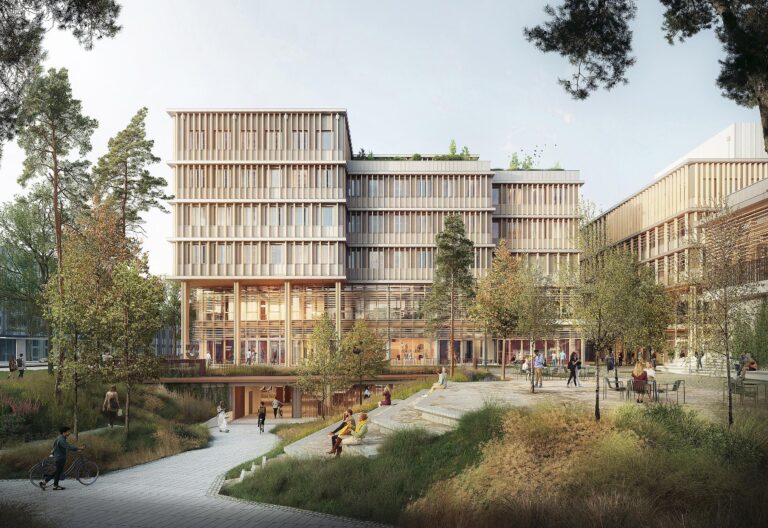Nantes Welcomes a New Era in Healthcare: Campus Santé Franceline Ribard
Nantes, France – In a significant leap forward for healthcare and medical education, the City of Nantes inaugurated the Campus SantĂ© Franceline Ribard, a cutting-edge facility designed to foster innovation and collaboration in health sciences. This ambitious project, which combines state-of-the-art infrastructure with modern teaching methodologies, aims to enhance the quality of healthcare services and training in the region. As the need for advanced medical solutions continues to grow, the Campus stands as a testament to France’s commitment to elevating its healthcare sector, making it a vital hub for both professionals and students alike. This article explores the features and implications of this pioneering institution, as well as its potential impact on the future of healthcare in Nantes and beyond.
Exploring the Innovative Architecture of Campus Sante Franceline Ribard in Nantes
The Campus Santé Franceline Ribard in Nantes stands as a testament to cutting-edge architectural ingenuity, designed with a commitment to fostering a collaborative and forward-thinking environment for health and research. Characterized by its fluid lines and expansive use of natural light, the building seamlessly integrates indoor and outdoor spaces, promoting wellness among its occupants. Key features of the architecture include:
- Sustainable Design: Incorporating green roofs and energy-efficient systems that align with contemporary environmental standards.
- Flexible Spaces: The layout offers multi-functional areas that adapt to various educational and research needs.
- Community Engagement: Open plazas and shared facilities designed to enhance interaction among students, researchers, and the local community.
The structure’s meticulous attention to detail extends beyond aesthetics; it emphasizes functionality and innovation in healthcare education. Notably, the integration of technology is pivotal in creating an interactive learning environment. The building houses specialized laboratories, simulation rooms, and collaborative workspaces that are essential for modern education. To illustrate the significance of these features, the following table highlights the prime elements of the design:
| Architectural Feature | Description |
|---|---|
| Natural Light | Strategic window placements enhance daylight exposure and reduce energy consumption. |
| Green Spaces | Landscaped areas encourage relaxation and provide a conducive environment for study. |
| Smart Technology | Integrates advanced learning tools, promoting a high-tech educational experience. |
The Role of Sustainable Design in Modern Healthcare Facilities
The integration of sustainable design principles in healthcare facilities like Campus Sante Franceline Ribard is transforming the way we approach health and wellness. By employing eco-friendly materials and energy-efficient technologies, these modern buildings not only reduce environmental impact but also create healthier environments for patients and staff. Key features often include:
- Natural Lighting: Enhancing patient recovery and staff productivity.
- Green Spaces: Incorporating gardens and plant life to reduce stress and improve air quality.
- Water Conservation: Implementing systems to recycle and conserve water usage.
Furthermore, sustainable design fosters a sense of community and connection, crucial for holistic healthcare. Facilities are increasingly designed with user experience in mind, promoting both functionality and wellness. The following table highlights essential elements of sustainable healthcare design:
| Element | Description |
|---|---|
| Renewable Energy Sources | Utilizing solar or wind to power facilities. |
| Efficient HVAC Systems | Reducing energy consumption while improving air quality. |
| Sustainable Transport Options | Encouraging public transit, cycling, and walking. |
Enhancing Patient Experience through Thoughtful Space Planning
At Campus Santé Franceline Ribard in Nantes, France, the focus on patient-centric design has led to a remarkable reimagination of healthcare spaces. Thoughtful space planning facilitates greater comfort and accessibility, transforming the traditional clinical environment into a sanctuary of healing. Key features include well-organized waiting areas, intuitive pathways that reduce anxiety, and private consultation rooms designed for patient dignity. The integration of natural light and green spaces enhances emotional well-being, proving that architecture can play a pivotal role in recovery.
Moreover, innovative use of technology seamlessly integrates with the thoughtful design principles. Features such as interactive kiosks and wayfinding applications guide patients through the facility while minimizing stress and confusion. The careful arrangement of spaces encourages community interaction and promotes a sense of belonging among patients and families. As healthcare evolves, the implementation of such attributes highlights the crucial connection between spatial experiences and positive health outcomes.
Future Developments and Investment Opportunities in Nantes’ Healthcare Sector
Nantes is poised for significant growth in its healthcare sector, driven by a combination of innovation and strategic investments. Key players are focusing on enhancing research facilities, fostering public-private partnerships, and leveraging the strength of local universities. Emerging technologies in telemedicine and biotechnology are set to create a vibrant ecosystem that attracts both startups and established firms. With ongoing backing from governmental programs and an adept workforce, Nantes aims to position itself as a leading hub for healthcare innovation in France.
Investment opportunities are ripe across various segments, notably in the following areas:
- Biotechnology: Ongoing research initiatives are looking to translate discoveries into viable health solutions.
- Digital Health: Development of e-health platforms is transforming patient care and accessibility.
- Infrastructure: New healthcare facilities and expansion of existing ones are on the horizon to accommodate growing demand.
Moreover, the establishment of the Campus Santé Franceline Ribard illustrates a commitment to education and innovation in healthcare. This project aims to integrate health professionals from diverse disciplines, fostering collaboration that could lead to groundbreaking solutions. With a steady influx of funding and a supportive ecosystem, Nantes represents a promising landscape for investors looking to make a mark in healthcare.
Insights and Conclusions
As the spotlight on modern healthcare facilities continues to grow, the Campus Santé Franceline Ribard in Nantes stands out as a beacon of innovation and design. Integrating state-of-the-art technology with sustainable practices, this facility not only transforms the patient experience but also redefines the role of healthcare architecture in the 21st century. As it prepares to welcome patients and staff alike, the campus embodies a commitment to health and well-being, marking a significant milestone for both the local community and the broader landscape of healthcare in France. As we look ahead, the impact of the Campus Santé Franceline Ribard will undoubtedly resonate, shaping the future of healthcare environments across the nation and beyond.



